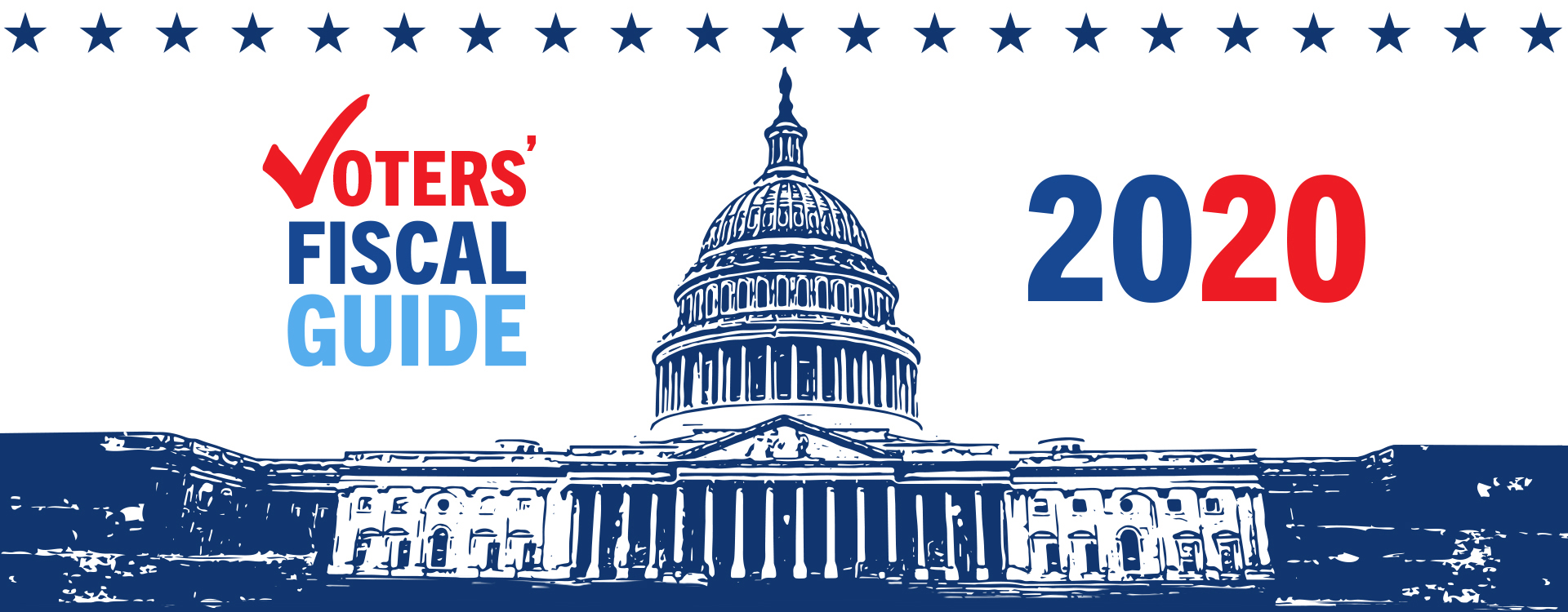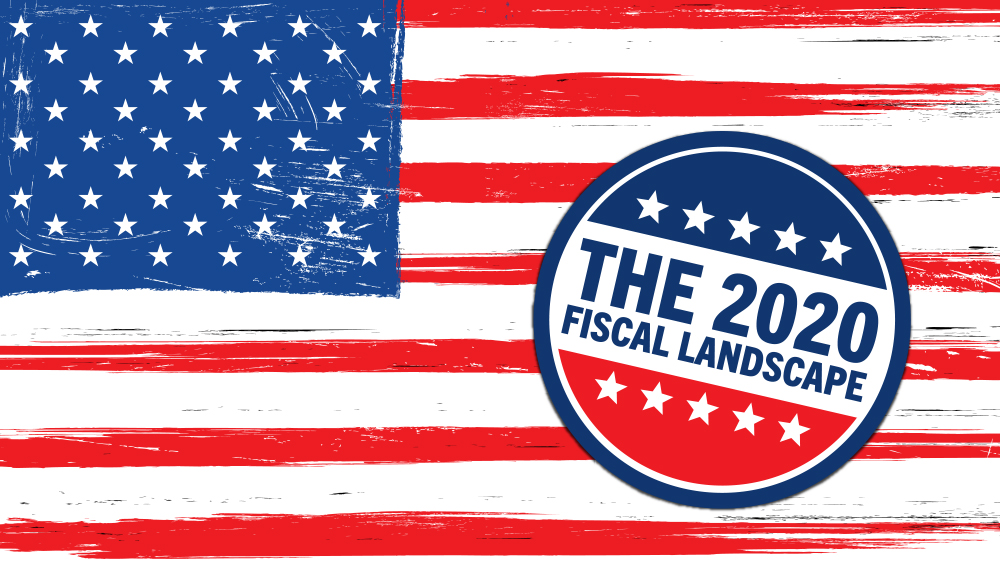Voters' Fiscal Guide 2020 | Peter G. Peterson Foundation


Your fiscal and economic headquarters for the 2020 election
With the national debt at $26 trillion and counting, the nation’s fiscal health is a key issue for the 2020 campaign.
Debt matters because it’s the one issue that impacts all others. This year, we’ll spend more than $1 billion every day on interest alone. That burden makes it harder to tackle big issues like climate change, infrastructure or national security. And the rising debt threatens economic opportunities for every American.
Get started by downloading our overview of the 2020 landscape or scroll down to read more for a range of nonpartisan, fact-based resources including charts, data, analyses, and voter perspectives to inform the conversations and coverage throughout the 2020 campaign.
The latest and trending
National Debt and Deficits
Historically, our largest deficits were associated with national emergencies like major wars or the Great Recession. Currently, though, the deficit results mainly from predictable structural factors: the aging baby boom generation, rising healthcare costs, skyrocketing interest, and a tax system that does not bring in enough money to pay for what the government has promised its citizens.
Top 10 Reasons Why the National Debt Matters
Here are the reasons that every voter has a stake in improving our fiscal outlook.
The National Debt Is Now More than $26 Trillion. What Does That Mean?
Over the past decade, the United States has added trillions of dollars to its national debt. Much of that growth in debt occurred as a result of the Great Recession, but even before that there was a structural mismatch between spending and revenues.
Debt Is Expected to Grow Faster in the United States than Anywhere Else in the World
No other country in the world is running up its national debt at the same pace as the United States. In fact, most are currently paying down their debt.
Key Drivers of the National Debt
The U.S. tax system does not bring in enough revenues to cover the spending policymakers have enacted. Learn about the two biggest drivers of federal spending.
Economic Growth
Rising debt means lower incomes and fewer economic opportunities for Americans. A strong fiscal outlook is an essential foundation for a growing, thriving economy.
The Economic Impact of the National Debt
Learn more about the connection between our government’s fiscal outlook and economic opportunities for individuals and families.
How Does the National Debt Affect the Economy?
Policymakers and pundits often depict fiscal responsibility and economic growth as being at odds with one another. In truth, however, a strong fiscal outlook is an essential foundation for a thriving economy.
Economic Growth Was Weaker in 2019 than in 2018
While the economy is expected to continue expanding over the next decade, the rate of growth is projected to slow.
Investing in the Future
Every day we spend more than $1 billion on interest on the national debt. Every dollar that goes toward interest payments means less resources available to build a stronger, more resilient future.
Public Investment in Our Future Has Fallen Sharply over the Past 50 Years
The share of the federal budget devoted to investment in our future has fallen sharply in recent decades and is now less than the amount we spend on interest on the national debt.
The National Debt Affects Our Ability to Address Key Priorities
Americans overwhelmingly agree that managing our debt is a key part of our ability to address a range of complex, interconnected challenges affecting our nation’s future.
How Much Government Spending Goes to Children?
Federal spending on children is a critical investment in the nation’s future. Unfortunately, it has fallen to its lowest level in a decade.
What Are the Economic Costs of Child Poverty?
Child poverty is higher in the United States than in many other developed countries – and it has a significant impact on our economy.
It’s Been 25 Years since We Last Raised the Gas Tax, and Its Purchasing Power Has Eroded
Because the gas tax is not pegged to inflation, its purchasing power has eroded significantly over the past two and a half decades, and America’s infrastructure network is suffering the consequences.
Economic Inequality
One of the more sobering economic trends over the past several decades has been the persistent weak wage growth for many workers and the rise in income inequality.
Income Inequality Continues to Rise
The gap between the lowest and highest earners in our society has grown significantly in recent decades, but federal taxes and programs play an important role in reducing that gap.
What are the Trends Slowing Wage Growth and Fueling Income Inequality?
A closer look at wage trends reveals why so many Americans are feeling left behind.
Healthcare
Healthcare is the most important issue for our nation’s fiscal and economic future. It represents nearly one-fifth of our entire economy, and it’s the second fastest growing part of the federal budget.
How Does the U.S. Healthcare System Compare to Other Countries?
The United States spends more on healthcare per person than other wealthy countries, but our health outcomes aren’t any better; in fact, they are often worse.
Why Are Americans Paying More for Healthcare?
Back in 1960, healthcare costs accounted for 5 percent of our GDP. Now it is almost 20 percent of our economy. Here are some of the reasons why those costs have exploded.
Millions Gained Healthcare Coverage under Obamacare, But That Trend Is Reversing
Millions of people gained healthcare coverage under the ACA, but the percent of uninsured has been growing over the last two years.
Why are Prescription Drug Prices Rising and How Do They Affect the U.S. Fiscal Outlook?
Prescription drugs play a vital role in the U.S. healthcare system, enabling Americans to lead longer, higher-quality lives – if they can afford them.
U.S. Healthcare Spending
It is estimated that the 30% of healthcare spending goes to unnecessary, ineffective, overpriced, and wasteful services.
Five Things You May Not Know about Medicaid
Medicaid insures nearly a quarter of all Americans. Some 2020 candidates have proposed expanding the program, while others would like to tighten requirements. Learn more about how it works now.
Budget Basics: Medicare
A number of 2020 candidates have proposed expanding Medicare in different ways. Learn more about how the program currently works and the financial pressures it faces.
Why the American Healthcare System Underperforms
Healthcare in the United States is very expensive — but we don’t get what we pay for.
Taxes
Tax reform done right would promote economic growth, make our fiscal outlook more sustainable, reduce the complexity and burden of compliance, and increase the system’s transparency and fairness.
Who Pays Taxes?
The fairness of our federal tax system is a hotly debated issue. Too often, however, those debates confuse or misrepresent important facts.
Two Years Later, What Are Economists Saying about the Tax Cuts and Jobs Act?
In 2017, Lawmakers enacted tax cuts for corporations and individuals. Here’s what economists are saying two years later.
What Is a Wealth Tax, and Should the United States Have One?
Some candidates have proposed a wealth tax to raise revenues and reduce income inequality. Here are the arguments for and against that approach.
How Does the Capital Gains Tax Work Now, and What Are Some Proposed Reforms?
The capital gains tax is a highly debated topic, as most presidential candidates have weighed in on how to revise it.
Payroll Taxes: What Are They and What Do They Fund?
The Social Security payroll tax only applies up to a certain amount of a worker’s annual earnings, meaning that higher-income earners pay a lower percent of their income. Some 2020 candidates have proposed eliminating that cap.
How Do Marginal Income Tax Rates Work — and What if We Increased Them?
Some lawmakers have proposed raising top marginal tax rates to combat rising inequality. Here’s an explanation of how they currently work and what the effects of raising them would be.
Defense Spending
Defense spending accounts for about 15 percent of all federal spending. Consequently, any serious efforts to address America's long-term fiscal challenges will have to consider reforms to defense.
The Facts about U.S. Defense Spending
National defense is a vital priority and a fundamental responsibility of the federal government. It is also a significant part of the federal budget – and often one of the more contentious budget issues.
National Security Solutions
We can maintain our level of preparedness and our superior military strength while also avoiding potential waste.
Polling
Leading up to the 2020 election, numerous independent polls show that voters across party lines are concerned about fiscal issues and their impact on national priorities.
Do Voters Care about the National Debt? The Polls Say They Do
Heading into 2020, the vast majority of Americans are urging leaders in Washington to address the unsustainable national debt and budget deficit.
FT-Peterson US Economic Monitor
What are Americans thinking about the state of the economy and the national debt? The Peterson Foundation has partnered with the Financial Times to track voter sentiment in the lead up to the 2020 election.
Fiscal Confidence Index
The Fiscal Confidence Index is designed to help policymakers, members of the media, and the American public gauge public opinion on the nation’s fiscal and economic challenges.
VOTERS AGREE: THE NATIONAL DEBT IS A BIPARTISAN PRIORITY FOR 2020 ELECTION
A broad, bipartisan majority of voters agree that the national debt is a key issue for the 2020 campaign.
© 2020 PETER G. PETERSON FOUNDATION. ALL RIGHTS RESERVED.

Social Security and Retirement
With the retirement of the baby boomers and lengthening life expectancy, programs critical to older Americans will come under significant strain in coming decades.
Five Charts about the Future of Social Security and Medicare
The aging of the population and increasing healthcare costs continue to put pressure on these programs and, without action, benefits in the future could be significantly reduced.
Read More
What Effect Does Social Security Have on Poverty?
Without income from Social Security, two-thirds of the elderly would live in poverty.
Read More
Three Major Challenges to Retirement Security
The number one financial worry for Americans is having enough money for retirement — and for good reason.
Read More